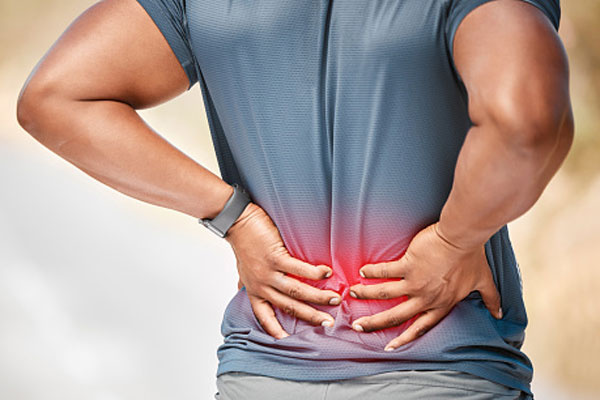Lumbar Pain
The lumbar spine, or lower back, is a well-constructed structure of interconnecting bones, joints, ligaments, muscles, and nerves, which work collectively to provide support, flexibility, and strength to the back. The lower back helps in everyday motions such as bending, twisting, and rotation of the hips during walking.
What is lumbar pain?
Lumbar pain or lower back pain is one of the most common reasons for visiting a doctor. Most people have experienced lower back pain at least once in their lifetime. People describe this pain as dull, sharp, and stabbing. It is considered one of the main reasons for absenteeism at work.

What are the symptoms of lumbar pain?
A combination of the following symptoms typically indicates a lower back pain:
- Dull, aching pain in the lower back.
- Severe pain soon after waking up, which gets better after moving.
- Legs, foot, and buttocks pain that radiates.
- Long periods of sitting make the pain worse.
- Pain that gets better with the change in the position.
The onset of symptoms can vary with the cause of back pain:
- Pain that develops slowly and worsens progressively.
- Pain that comes and goes but worsens with time.
- Immediate pain after an injury.
- Delayed symptoms after an injury.
What are the causes and risk factors for lumbar pain?
Lower back pain mainly results from injuries, such as muscle sprains or strains associated with sudden body movements or improper lifting of heavy objects.
A reduction in the fluid volume between the vertebrae of the spine can lead to irritation and tearing of the discs in the spine. This is common with aging. Therefore, people aged between 30 and 50 are at higher risk of lower back pain.
Additionally, loss of muscle tone increases the susceptibility to back injuries, which may result in lower back pain. Lower back pain can also result from diseases such as:
- Arthritis
- Kidney infections
- Infections of the spine
- Cancer of the spinal cord
- Sciatica
How is lumbar pain diagnosed?
The doctor reviews the patient's complete medical history and conducts a physical examination. He or she may check for a range of motion, reflexes, and responses to see if the nerves are affected.
If the below debilitating symptoms are present, the doctor will send the patient for further testing:
- Fever
- Unintentional weight loss
- Weakness
- Lack of bowel control
Lower back pain usually resolves with simple home treatment. But if the pain continues even after these self-care measures, additional testing may be necessary.Lower back pain usually resolves with simple home treatment. But, if the pain continues even after these self-care measures, additional testing may be necessary.
Imaging tests, such as X-rays, an MRI scan, a CT scan, or an ultrasound scan, may be obtained to detect:
- Disc problems
- Bone problems
- Problems with the ligaments and tendons of the back
A bone scan or bone density test may be ordered if the doctor suspects weakening of the bones. Electromyography helps identify nerve problems.
What are the treatment options?
Self-care
Self-care methods are helpful during the first 72 hours after the onset of pain. These measures include:
- Avoiding physical activities for 2-3 days.
- Applying ice packs to the lower back for the first 48-72 hours, followed by heat treatment. This helps in relaxing the muscles.
- Taking over-the-counter medications, such as acetaminophen, or ibuprofen, to relieve pain.
- Alternately, you can also lie on your side.
- Massaging the back to reduce muscle stiffness.
Consult a doctor if the pain does not get better with the above self-care methods. The doctor may choose one or more of the following treatments:
Medications that may be prescribed include:
- Muscle relaxants (to relive muscle stiffness)
- NSAIDs (non-steroidal anti-inflammatory medications) are used to treat inflammation and pain.
- Corticosteroids injections (to reduce inflammation)
- Narcotics such as codeine (to relieve severe back pain)
Physical therapies include:
- Massage
- Strengthening exercises
- Stretching
- Back and spinal manipulation
If the above therapies fail, surgery becomes the final option. The surgical procedures may include:
- Foraminotomy, to open the bony hole in the spinal cord through which the nerve roots run.
- Discectomy involves the removal of a piece of the bony part of the spinal canal known as the lamina to relieve pressure from the nerve root resulting from a bulging disc.
- Neucleoplasty is a procedure in which a special device is inserted into the disc to remove the inner material. Later, radio waves are used to shrink the tissue.
- Spinal fusion involves the removal of discs between two or more vertebrae, followed by the fusion of the vertebrae with bone grafts or special metal screws.
- Spinal laminectomy removes the lamina to increase the size of the spinal canal, thereby relieving the pressure on the spinal cord.
Prevention
Back pain can be prevented by the following activities:
- Using good body posture to strengthen the back muscles.
- Exercising to relieve muscle stiffness in the back and abdomen.
- Losing extra weight.
- Lifting objects properly.
- Avoiding high-heeled footwear.
- Smoking cessation.